
 Bill Burhans served as a tour officer with the USMLM Air Team from July 1971 to June 1975. He returned in 1979 to command Detachment 16,
7113th Special Activities Squadron (the Air Team), departing in early spring 1980 following a December 1979 Soviet-originated nasty incident.
One of his first sorties in 1971 was for the Wittstock firing range, where he
witnessed LABS training with simulated nuclear weapons. This proved to be an unforgettable experience...
Bill Burhans served as a tour officer with the USMLM Air Team from July 1971 to June 1975. He returned in 1979 to command Detachment 16,
7113th Special Activities Squadron (the Air Team), departing in early spring 1980 following a December 1979 Soviet-originated nasty incident.
One of his first sorties in 1971 was for the Wittstock firing range, where he
witnessed LABS training with simulated nuclear weapons. This proved to be an unforgettable experience...
In order to determine how Soviet air units would provide support in wartime to Group of Soviet Forces in Germany ground units, it was very important for the intelligence collectors assigned to the Air Team, the US Air Force element within the United States Military Liaison Mission operating in East Germany, to monitor the tactics 16th Air Army flying units employed. One of the best ways to accomplish this was to watch Soviet aircraft crews practice their assigned missions at the numerous bombing and gunnery ranges in the GDR.
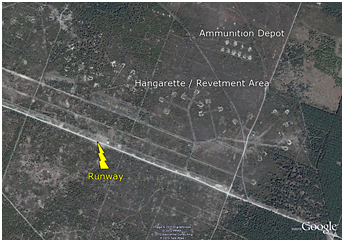
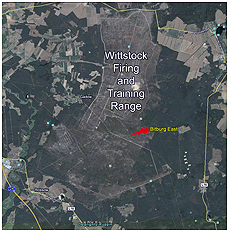 A prominent example of such ranges was located a few kilometers southeast of the city of Wittstock
between the small towns of Gadow and Rossow. We had learned from aerial observations that the Soviets
had essentially copied the layout of the US air base at Bitburg in West Germany. Thus, the Gadow-
Rossow Range also was referred to as “Bitburg East” [Wittstock polygon or range for the Soviets].
A prominent example of such ranges was located a few kilometers southeast of the city of Wittstock
between the small towns of Gadow and Rossow. We had learned from aerial observations that the Soviets
had essentially copied the layout of the US air base at Bitburg in West Germany. Thus, the Gadow-
Rossow Range also was referred to as “Bitburg East” [Wittstock polygon or range for the Soviets].
As was the case for all major training areas and ranges, a large permanent restricted area (PRA)
protected “Bitburg East.” There was a favorite place that Air Team reconnaissance tours liked to use to
cover aerial activity at this important range. Fortunately, there were lots of woods in this particular area,
which made coverage of this target feasible. The trick was to be able to reach the general area unobserved, enter
the woods and find a suitable observation point (OP). The down side was that this was such a popular location to observe
range activity that Stasi surveillance personnel were very familiar with such haunts and checked them regularly any time
an allied foreign liaison mission reconnaissance tour was observed in the general area.
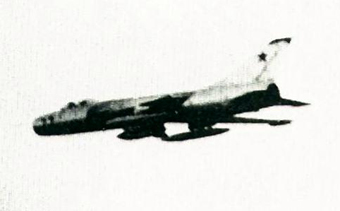 Un Su-7B du 20.GvIBAP sur le point d'effectuer un bombardement en ressource au-dessus du polygone de
Wittstock le 15 octobre 1971. Il était armé d'une bombe de type IAB-500 simulant une arme nucléaire et il emportait
également deux réservoirs supplémentaires. © USMLM.
Un Su-7B du 20.GvIBAP sur le point d'effectuer un bombardement en ressource au-dessus du polygone de
Wittstock le 15 octobre 1971. Il était armé d'une bombe de type IAB-500 simulant une arme nucléaire et il emportait
également deux réservoirs supplémentaires. © USMLM.
A Su-7B of the 20.GvIBAP almost ready to start a LABS maneuver above the Wittstock
firing range on 15 October 1971. It was carrying two external fuel tanks underwing and
an IAB-500 bomb simulating a nuclear weapon was suspended under the fuselage. © USMLM.
 The first time I was involved in activity at Gadow-Rossow was during my on-the-job training (OJT).
I was back-seating with Major Lynn Hansen and Technical Sergeant Nick Netter in the morning of October 15, 1971.
I don’t know if Lynn had advanced knowledge of the activity, but we did a considerable amount of circuitous
travel before ending up in the woods between the field trails via which we had approached the area and the PRA boundary.
Here was the dilemma - just how
wide was that pencil line on the PRA map? Since you could see a gap between the wood line demarcating where we had set up
and the pencil line depicting the edge of the PRA, we considered ourselves to be outside the PRA. We at least could
argue that point should something untoward happen. Perhaps not a strong arguing point, but it was at least something. . .
The first time I was involved in activity at Gadow-Rossow was during my on-the-job training (OJT).
I was back-seating with Major Lynn Hansen and Technical Sergeant Nick Netter in the morning of October 15, 1971.
I don’t know if Lynn had advanced knowledge of the activity, but we did a considerable amount of circuitous
travel before ending up in the woods between the field trails via which we had approached the area and the PRA boundary.
Here was the dilemma - just how
wide was that pencil line on the PRA map? Since you could see a gap between the wood line demarcating where we had set up
and the pencil line depicting the edge of the PRA, we considered ourselves to be outside the PRA. We at least could
argue that point should something untoward happen. Perhaps not a strong arguing point, but it was at least something. . .
If my memory is anywhere near correct, we were in the vicinity of the high point marked “71” on the map to the left,
due west of Katerbow.
We weren’t in position very long before the activity began.
FITTER B (Su-7B) with side number 77 came screeching overhead from behind us, approaching the range from the south.
Based on aircraft type and the color of the side number, this aircraft was from the 20th Guards Fighter-Bomber Aviation Regiment
based at Gross Dölln due east of Wittstock not far from the range.
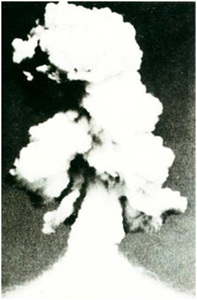
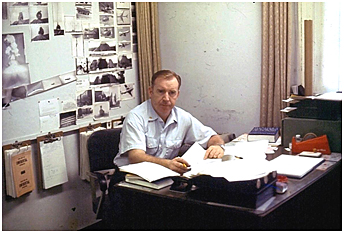 This aircraft was very low, I would guess at an altitude of approximately 300 meters. We watched as the pilot put
the aircraft into a vertical climb just before reaching the dummy targets on the range. The pilot released the simulated
weapon, the aircraft continued to climb to an altitude of about 4000 meters, and then the pilot performed an Immelmann
maneuver and exited the area in the same direction from which he had approached the target area. This turned out to be the
first of several such passes over the range, eight or ten as I recall.
After the first aircraft disappeared, we all prepared ourselves for subsequent activity. I was positioned at an angle of
90° to the target while looking to my right awaiting the next aircraft. My guess was correct - all subsequent FITTER B flew
the same pattern from our right to our left and, like the first one we saw, performed an Over-the-Shoulder Low Altitude
Bomb System (LABS) maneuver employed when aircraft delivered tactical nuclear weapons on a target.
This aircraft was very low, I would guess at an altitude of approximately 300 meters. We watched as the pilot put
the aircraft into a vertical climb just before reaching the dummy targets on the range. The pilot released the simulated
weapon, the aircraft continued to climb to an altitude of about 4000 meters, and then the pilot performed an Immelmann
maneuver and exited the area in the same direction from which he had approached the target area. This turned out to be the
first of several such passes over the range, eight or ten as I recall.
After the first aircraft disappeared, we all prepared ourselves for subsequent activity. I was positioned at an angle of
90° to the target while looking to my right awaiting the next aircraft. My guess was correct - all subsequent FITTER B flew
the same pattern from our right to our left and, like the first one we saw, performed an Over-the-Shoulder Low Altitude
Bomb System (LABS) maneuver employed when aircraft delivered tactical nuclear weapons on a target.
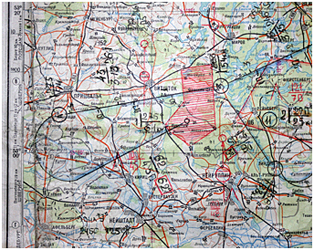
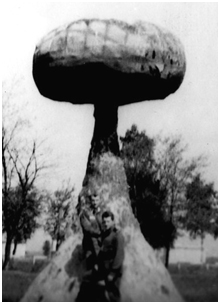 On pouvait trouver dans différentes garnisons soviétiques des "maquettes" de champignons nucléaires destinés à aider
les jeunes recrues à les identifier. Celui-ci se trouvait au sud du champ de tir de Wittstock, près de Storbeck. © A.Trostnikov.
On pouvait trouver dans différentes garnisons soviétiques des "maquettes" de champignons nucléaires destinés à aider
les jeunes recrues à les identifier. Celui-ci se trouvait au sud du champ de tir de Wittstock, près de Storbeck. © A.Trostnikov.
One could find in various Soviet garrisons "models" of nuclear mushrooms intended to help
young recruits to identify them. This one was located south of the Wittstock firing range, near Storbeck. © A.Trostnikov.
Each aircraft carried a center-mounted simulated nuclear weapon that itself mounted a red flare. The purpose of the
flare was to facilitate tracking of the trajectory of the weapon by the Soviet range authorities. Naturally, this flare
served the same purpose for us! It was clearly visible as the aircraft began its high-speed vertical climb and, when the
weapon was released, it was very easy to follow as it continued up and up and up until, having lost its momentum, it looped
over and begin its descent towards the target. At the altitude assigned for the airburst, we would notice a small puff of
smoke and could hear the distant sound of a detonation.
The motor drive on my Nikon-F camera came into play here. I was able to follow the aircraft all the way through this
maneuver by keying in on the red flare. Once I became accustomed to the procedure the Soviet pilots were using, I knew how
much time to wait before clicking off the next frame. I exposed between 30 and 34 frames of each 36-frame roll of Kodak Tri-X
film for each pass, meaning that I had to change rolls after every aircraft delivery run. I am glad there was sufficient time
between attacking aircraft to allow me to do this.
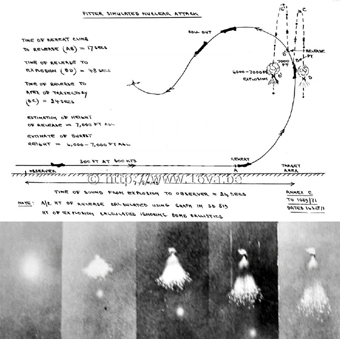
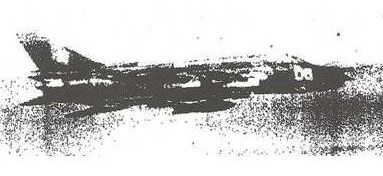 Le 17 mai 1985, le Su-17M4 n°06 du 730.APIB a été photographié armé d'une bombe IAB-500 lors d'une attaque de type LABS.
Il s'agissait de la première observation d'un "Fitter-K" avec ce type d'arme au sein du GFSA. Pas moins de 64 profils de bombardement ou de tir
de missiles air-sol ont été notés ce jour-là. Le point culminant fut une explosion nucléaire simulée, chose qui n'avait plus été observée depuis
plusieurs années en RDA. © BRIXMIS.
Le 17 mai 1985, le Su-17M4 n°06 du 730.APIB a été photographié armé d'une bombe IAB-500 lors d'une attaque de type LABS.
Il s'agissait de la première observation d'un "Fitter-K" avec ce type d'arme au sein du GFSA. Pas moins de 64 profils de bombardement ou de tir
de missiles air-sol ont été notés ce jour-là. Le point culminant fut une explosion nucléaire simulée, chose qui n'avait plus été observée depuis
plusieurs années en RDA. © BRIXMIS.
On 17 May 1985, Su-17M4 n°06 of the 730.APIB carried out a probable toss-bomb attack carrying an
IAB-500 bomb that seemingly was the first-sighting on a "Fitter-K" of the GSFG. The attack was part of a programme of 64
bomb and TASM profiles. The end product, a simulated nuclear explosion, had not been seen in the GDR for a number of years. © BRIXMIS.
The entire exercise was impressive enough in and of itself, but the climax was something else again. It actually was very chilling!
The last aircraft delivered a special simulator [most certainly an IAB-500 bomb]. When the simulated weapon finally had descended
to perhaps 1000 meters above its intended target, an explosion occurred.
The result was the huge extremely realistic-looking mushroom cloud shown above and also visible on the "Wall of Honor" off the right shoulder
of Major Hansen shown seated at his desk, on the top right picture.
I must admit I had the shivers while looking at that cloud. I am sure Lynn and Nick had exactly the same reaction. We were about
five miles from this event, but that distance would have made no difference at all had this been a real nuclear detonation. . .
I do not think I will ever forget that sight. Believe me, it was a chastened trio that climbed into the Ford Fairlane 500 tour vehicle
and departed the range area after activity ceased.
- Bitburg East > Here
- A simulated nuclear explosion can be watched briefly at 5'06" on this
video about the Su-17
- Short video showing a Su-7 armed with an IAB-500 bomb >
Link or download > Here.
All those weapons were externally similar - see > Special Weapons, part 1.
- IAB-500 bombs still in use in 2020: picture of an armed Su-30SM > link.
 |
Plan du site - Sitemap |  |
